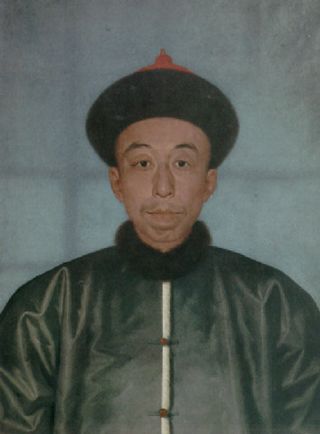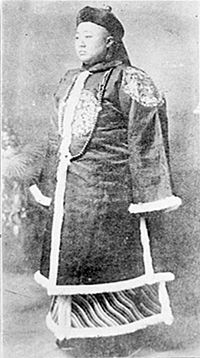
Prince Guo of the First Rank, or simply Prince Guo, was the title of a princely peerage used in China during the Manchu-led Qing dynasty (1644–1912). As the Prince Guo peerage was not awarded "iron-cap" status, this meant that each successive bearer of the title would normally start off with a title downgraded by one rank vis-à-vis that held by his predecessor. However, the title would generally not be downgraded to any lower than a feng'en fuguo gong except under special circumstances.

Prince Qing of the First Rank, or simply Prince Qing, was the title of a princely peerage used in China during the Manchu-led Qing dynasty (1636–1912). It was also one of the 12 "iron-cap" princely peerages in the Qing dynasty, which meant that the title could be passed down without being downgraded.
Prince Zheng of the First Rank, or simply Prince Zheng, was the title of a princely peerage used in China during the Manchu-led Qing dynasty (1644–1912). It was also one of the 12 "iron-cap" princely peerages in the Qing dynasty, which meant that the title could be passed down without being downgraded.
Yongrong was a Manchu prince and calligrapher of the Qing dynasty in China. He was born in the Aisin Gioro clan as the sixth son of the Qianlong Emperor; his mother was Imperial Noble Consort Chunhui.
Prince Su of the First Rank, or simply Prince Su, was the title of a princely peerage of the Manchu-led Qing dynasty of China (1636–1912). It was also one of the 12 "iron-cap" princely peerages in the Qing dynasty, which meant that the title could be passed down without being downgraded.
Prince Jingjin of the First Rank, or simply Prince Jingjin, was the title of a princely peerage used in China during the Manchu-led Qing dynasty (1644–1912).
Prince Yu of the First Rank, or simply Prince Yu, was the title of a princely peerage used in China during the Manchu-led Qing dynasty (1644–1912). As the Prince Yu peerage was not awarded "iron-cap" status, this meant that each successive bearer of the title would normally start off with a title downgraded by one rank vis-à-vis that held by his predecessor. However, the title would generally not be downgraded to any lower than a feng'en fuguo gong except under special circumstances.
Prince Chun of the First Rank, or simply Prince Chun, was the title of a princely peerage used in China during the Manchu-led Qing dynasty (1644–1912). As the Prince Chun peerage was not awarded "iron-cap" status, this meant that each successive bearer of the title would normally start off with a title downgraded by one rank vis-à-vis that held by his predecessor. However, the title would generally not be downgraded to any lower than a feng'en fuguo gong except under special circumstances.
Prince Xian of the First Rank, or simply Prince Xian, was the title of a princely peerage used in China during the Manchu-led Qing dynasty (1636–1912). As the Prince Xian peerage was not awarded "iron-cap" status, this meant that each successive bearer of the title would normally start off with a title downgraded by one rank vis-à-vis that held by his predecessor. However, the title would generally not be downgraded to any lower than a feng'en fuguo gong except under special circumstances.
Prince Ding of the First Rank, or simply Prince Ding, was the title of a princely peerage used in China during the Manchu-led Qing dynasty (1636–1912). As the Prince Ding peerage was not awarded "iron-cap" status, this meant that each successive bearer of the title would normally start off with a title downgraded by one rank vis-à-vis that held by his predecessor. However, the title would generally not be downgraded to any lower than a feng'en fuguo gong except under special circumstances.
Prince Yi of the First Rank, or simply Prince Yi, was the title of a princely peerage used in China during the Manchu-led Qing dynasty (1644–1912). It was also one of the 12 "iron-cap" princely peerages in the Qing dynasty, which meant that the title could be passed down without being downgraded.
Prince Li of the First Rank, or simply Prince Li, was the title of a princely peerage of the Manchu-led Qing dynasty of China. It was also one of the 12 "iron-cap" princely peerages in the Qing dynasty, which meant that the title could be passed down without being downgraded.
Prince Rui of the First Rank, or simply Prince Rui, was the title of a princely peerage used in China during the Manchu-led Qing dynasty (1636–1912). It was also one of the 12 "iron-cap" princely peerages in the Qing dynasty, which meant that the title could be passed down without being downgraded.

Prince Rui of the First Rank, or simply Prince Rui, was the title of a princely peerage used in China during the Manchu-led Qing dynasty (1636–1912). As the Prince Rui peerage was not awarded "iron-cap" status, this meant that each successive bearer of the title would normally start off with a title downgraded by one rank vis-à-vis that held by his predecessor. However, the title would generally not be downgraded to any lower than a feng'en fuguo gong except under special circumstances.
Prince Shen of the Second Rank, or simply Prince Shen, was the title of a princely peerage used in China during the Manchu-led Qing dynasty (1636–1912). It was renamed to "Prince Zhi of the Second Rank" in 1772 and upgraded to Prince Zhi of the First Rank in 1789.
Prince Cheng of the First Rank, or simply Prince Cheng, was the title of a princely peerage used in China during the Manchu-led Qing dynasty (1636–1912). As the Prince Cheng peerage was not awarded "iron-cap" status, this meant that each successive bearer of the title would normally start off with a title downgraded by one rank vis-à-vis that held by his predecessor. However, the title would generally not be downgraded to any lower than a feng'en fuguo gong except under special circumstances.
Prince Hui of the First Rank, or simply Prince Hui, was the title of a princely peerage used in China during the Manchu-led Qing dynasty (1644–1912). As the Prince Hui peerage was not awarded "iron-cap" status, this meant that each successive bearer of the title would normally start off with a title downgraded by one rank vis-à-vis that held by his predecessor. However, the title would generally not be downgraded to any lower than a feng'en fuguo gong except under special circumstances.
Yunlu, born Yinlu, was a Manchu prince of the Qing dynasty.
Hongpu was Qing dynasty imperial peer prince and second son of Yunlu, Prince Zhuang Ke of the First Rank. Although he never held a title of the prince of the first rank, his eldest son was selected to succeed the Prince Zhuang peerage.
A coup of Hongxi was an unsuccessful coup d'etat organised by Hongxi, Prince Li of the First Rank and the eldest surviving son of deposed crown prince Yunreng and other co-conspirators, most of whom were sons of the imperial princes who did not participate in the succession brawl between Yinzhen, Yunzhi, Yunsi and their supporters.



